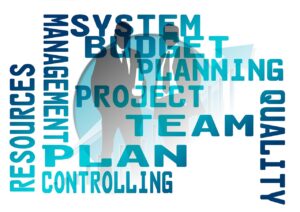Different types of business systems make up an integral part of any business, and understanding them can ensure that your business runs efficiently and effectively.
This article evaluates the most common types of business systems, how they work, and how they can streamline your processes and operations.
Are Systems Beneficial to Small Businesses?
Absolutely!
A system is a procedure, process, method, or course of action designed to achieve a specific result. Its component parts and interrelated steps work together for the good of the whole. Creating effective business systems is the only way to attain results that are consistent, measurable, and ultimately benefit customers.
Systems are frameworks designed to help businesses operate more efficiently by streamlining processes and optimizing resources.

Each business system is designed to help businesses manage different operations, from tracking customer data to managing inventory.
Having effective business systems is the only practical way to manage the important details of your operation. These details are found in lower-level subsystems. For example, your marketing system may have a subsystem called lead generation.
Your lead generation system could have subsystems such as direct mail, telemarketing, or radio advertising. Systems and subsystems are the workhorses that deliver consistent results, even when you’re not around.
A business system may be as simple as a checklist. However, more complex systems can take days or even weeks to implement. The best systems consider such elements as design, components, people, quality, speed and measurement.
Understanding how each system works can help businesses make better decisions and improve their overall performance.
Imagine the typical business activities below as carefully designed systems, each producing the daily results you need to be successful. Of course, you could list many other systems and subsystems unique to your organization.
Types of Business Systems
Common Types of Business Management Systems in Small Businesses
We will discuss a few of the common types of business systems below.
Types of Business Systems – Lead Generation
Lead generation is a business system that is used to identify buyers and generate interest in a business’s products or services.
It typically involves creating marketing campaigns that target potential customers, such as email campaigns, search engine optimization, and social media outreach.
Once interested buyers are identified, the business can nurture the relationship and move them further down the funnel toward making a purchase.
Payroll
Payroll is a business system used for managing and administering employee compensation. It includes tracking employee hours, calculating wages, deductions and taxes, and issuing paychecks or direct deposits.
It can also involve other aspects such as garnishments, bonuses, and pension contributions. The payroll system helps businesses ensure compliance with all applicable tax laws and labor regulations.
Operations
An operations management system coordinates a business’s day-to-day activities for order fulfillment.
It typically involves planning resources and processes, developing systems to improve efficiency and productivity, monitoring performance standards, overseeing customer service operations, and managing vendor relationships.
The operations system helps businesses streamline their processes to maximize efficiency and productivity.
Inventory Management
Inventory is a business system designed to track the flow of raw materials, inventory levels, and finished goods to meet customer demand while minimizing costs.

It involves data analysis to determine how much of each item should be held in inventory, tracking supplier delivery times to ensure timely delivery of goods, and calculating inventory costs to identify opportunities for cost savings.
The inventory system helps businesses manage their resources more efficiently.
Workforce Management
Workforce management is a business system that plans, manages, and optimizes an organization’s human resources. It covers all aspects of personnel management, including recruiting, developing, and retaining employees.
Other types of business systems include production management, customer relationship management, business intelligence, supply chain management, sales and marketing automation, data analytics, and human resources.
Why do Businesses Need Systems?
Increased Efficiency: Business systems help automate processes, streamline workflow and reduce human effort, enabling businesses to operate quickly, accurately and efficiently with fewer resources.
Improved Decision-Making: Business systems provide managers with the tools to generate timely, accurate reports that can be used to make informed decisions about the company’s operations.
Reduced Costs: Automating processes reduces labor costs and other costs such as energy consumption, office supplies, and communications costs.
Improved Customer Satisfaction: Business systems can automate customer service functions, allowing customers to quickly get answers. Automated systems also provide greater accuracy and consistency in customer service, ultimately leading to improved customer satisfaction.
Build A Business System Framework
Small businesses can use a variety of approaches to build business systems but the framework for doing so remains the same with four main steps.
1.First, examine your existing business processes to know the current state , and determine how they may be streamlined or automated.
This could include establishing procedures for customer service, sales and marketing, accounting, and internal operations. Once the processes are described, the business can identify the software tools needed to support them.
2. Next, develop an IT infrastructure capable of providing the necessary support. Once the infrastructure is in place, the business can select and implement necessary software tools for marketing, accounting, and customer service.
Note that many businesses would have decided on their minimal IT infrastructure even before identifying necessary software. For such businesses, a re-evaluation of the IT infrastructure should be made at this stage.
3. Finally, plan and schedule to regularly evaluate your systems to ensure they are up-to-date and functioning properly. This could involve testing new features and making necessary changes to the software or network.
4. Also analyze systems output data and metrics to understand how well the system is being used and if it meets desired set goals.
By taking these steps, your small business can establish robust business systems that will help you to maximize efficiency and productivity.
Conclusion – Types of Business Management Systems
Every business needs different types of business systems that can integrate accounting, marketing, and customer service and operations. None of these business systems should ever operate in isolation.
By selecting the right software tools, you can ensure that you are using the most up-to-date technology to optimize resources.
Finally, regular evaluation and data analysis will assist with monitoring to ensure that the systems are functioning properly to achieve desired goals.
For assistance with building your business systems, CONTACT US HERE
Related Articles
- Create Business Systems – Learn How to Move From Chaos to Clarity
- How to Build a Business System – Tips and Examples
- What Causes Chaos in Business Operations – Time to Stop It
- What is a Business Management System – Think Business Goals
- What is a Business System – How to Create Consistency
- What is the Difference Between Systems and Processes – Know Them
References
Business systems: What are they and how will they help your business? (myob.com)

